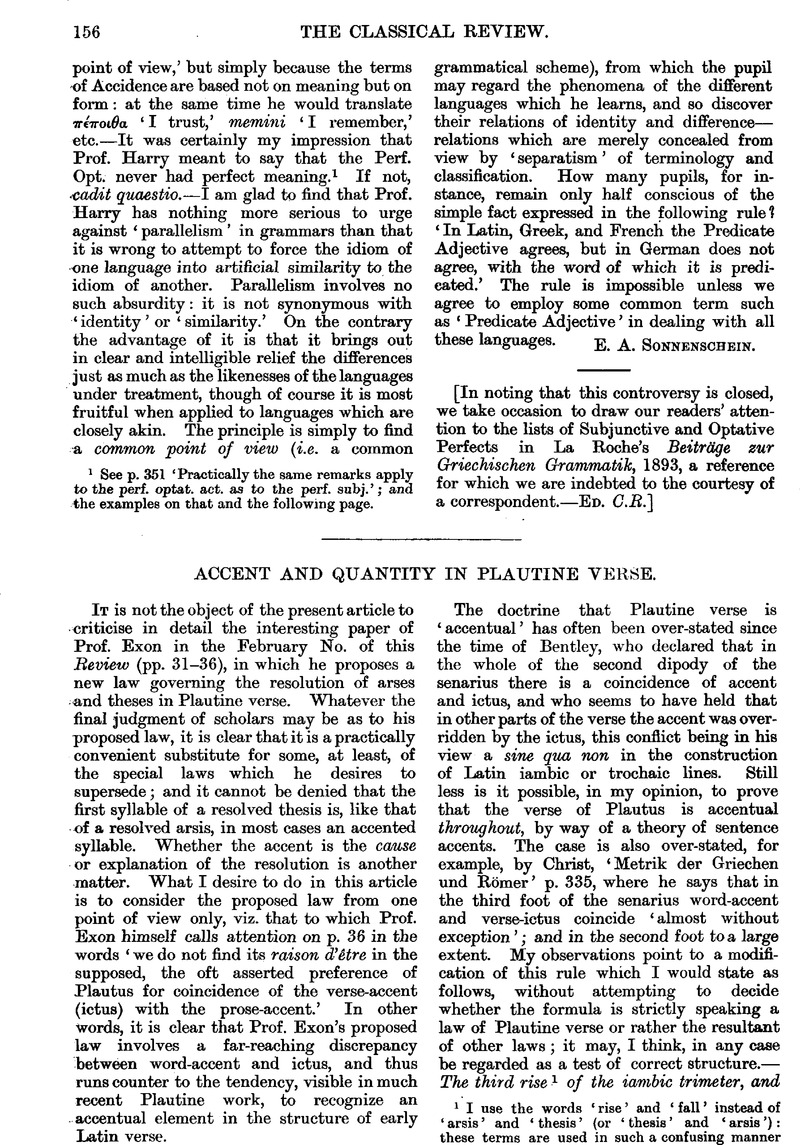No CrossRef data available.
Article contents
Accent and Quantity in Plautine Verse
Published online by Cambridge University Press: 27 October 2009
Abstract

- Type
- Original Contributions
- Information
- Copyright
- Copyright © The Classical Association 1906
References
page 156 note 1 I use the words ‘rise’ and ‘fall’ instead of ‘arsis’ and ‘thesis’ (or ‘thesis’ and ‘arsis’): these terms are used in such a confusing manner by different writers as hardly to suggest any definite idea to the reader until he has found the place in his book in which they are defined. ‘Rise’ and ‘fall’ I find convenient to denote the crest and the trough of a wave of sound, like the German terms ‘Hebung’ and ‘Senkung’; and some corresponding terms I feel to be badly wanted in English.
page 157 note 1 Words like eun, meum, etc. may be scanned either with synizesis or without it (éum, méum) lines like Bacch. 769, Stich. 457. It makes no difference to my rule which method is adopted.
page 157 note 2 The negative is wrongly placed: perhaps we should read unum haud intermíssumst hic esse et bibi. Is it Latin to say est haud intermissum for haud est interm. or haud interm. est?
page 158 note 1 Lines like the following, which are exceptional according to the Dipody Law, are legal according to my law: Aul. 336, Merc. 988, Poen. 402, Rud. 595, to say nothing of lines like Rud. 507, Amph. 592, etc. ; so too lines like Asin. 529, 800, Bacch. 438, Epid. 400, Merc. 860, Cas. 426, etc. Note the secondary accent and cf. Klotz, , Grundzüge, pp. 333 ff.Google Scholar
page 158 note 2 I might add that in good English verse the rises are formed by long syllables or two equivalent shorts to a much greater extent than is recognized by the current theory of English verse—the longs being, of course, also accented : e.g. ‘And chiefly thou, O Spǐrǐt that dost prefer.’
page 159 note 1 On this point see ProfRadford, in Transactions of the American Philological Association, 1904, p. 44.Google Scholar
page 159 note 2 I have counted 24 instances of the word aduenientem (-is, -i, etc.) in Plautine senarii and trochaic septenarii: possibly a few have escaped me. But of these 24, 18 (three-quarters of the whole number) make the line accentual at some point or another, if we assume the accents àdueniéntem : in 6 of these 18 (one quarter of the whole) the first syllable comes at the critical rise of the verse : viz. Amph. Prol. 150, 714, 978, Bacch. 197, Epid. 435, 662. In all these passages the accent aduèniéntem, involved in Prof. Exon's theory, makes the line unaccentual at the place where all normal lines are accentual. In 6 instances (a quarter of the whole) the two syllables -ueni- form a rise, but only at points of the verse where, according to my theory, accentual rhythm is not necessary : viz. Amph. 706, Bacch. 538, 769, Capt. 1004, Stich. 422, 740. [The other passages are Amph. 711, Bacch. 101, 186, Epid. 126, Men. 724, Most. 389, 430, 1124, Poen. 1151, Stich. 457, Trin. 869, 997 : total 12, in which the first syllable occurs at other rises than the critical ones. Here too, of course, Prof. Exon's theory makes the rises unaccentual ; but I do not claim that these rises are necessarily accentual.]


